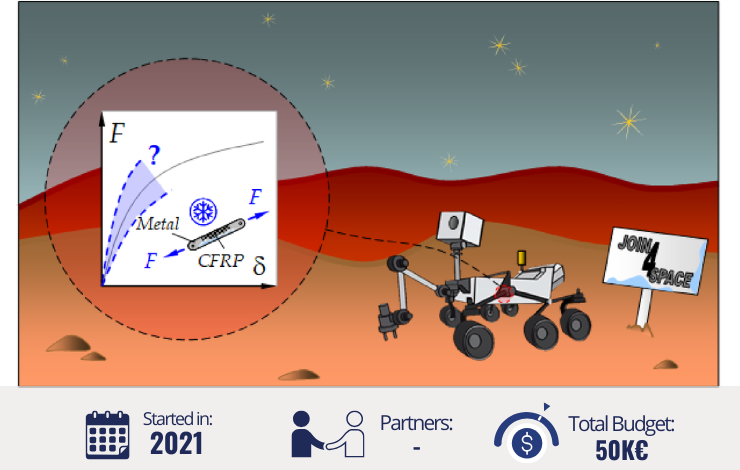
Starting Date: 2021
Number of Partners: –
Total Budget: 50K€
On February 18th, 2021, the world assisted in the first step for the Mars conquer through the 1,025 kg Perseverance rover which was equipped with a 1.8 kg-small helicopter drone called Engenuity. Made with lightweight materials and with high strengths, this rover has similar dimensions to a car!
To make the weight of the rover and the small drone even lighter, multi-material structures (MMS) can be the next step but the transition between one material to another should be made without increasing the weight of the structure and, at the same time, preserving the integrity of the MMS. However, after exposure to very harsh environments, these transition points, if bonded with an adhesive, are susceptible to degradation and damage.
For instance, Mars’s atmosphere is about 100 times thinner than Earth’s, and therefore, Mars can’t retain any heat energy provided by solar radiation, during the night, these types of equipment have to face a harsh environment on Mars with almost -100ºC. So, soon, humankind must enhance the actual MMS structures to develop other rovers and assist other space missions to explore the unexplored in our solar space. To help with this demand, the present project aims to study the critical transition points between metal and composite in MMS and contribute to the increase of the current knowledge on the behaviour of those joints when subjected to cryogenic temperatures. This is a crucial task since the maximization of the strength-to-weight ratio of MMS is only possible if those critical transition points are correctly understood and designed.
From an exploratory perspective, this project is organized to identify the optimum joint configuration that can better resist cryogenic temperatures similar to those found in outer space ( 270ºC). During the project period, two main different approaches will be followed. One is numerical whereas the other one is experimental. The former activity has three main tasks to be developed. The first task will initiate with the initiation of the project and it aims to identify the most promising joining configurations that are worthy to be experimentally tested. The second task of this first activity aims to model the tested specimens under cryogenic temperature. In the end, and along with the knowledge acquired during the project period, the third task is focused on seeking other and improved solutions to be worthy of investigation in the future, i.e. in a project post-period. To support the experimental work to be carried out in this project, a cryogenic chamber will be designed and developed which should be compatible with the tensile testing machine available in our facilities.
The development of different experimental tests, as well as several numerical simulations, will help to write a textbook where different design recommendations and construction details will be drawn and described thoroughly. The project will benefit also from synergies between four advanced scientific academic groups (Mechanical, Civil, Material, and Physic Engineering) that, all combined, will allow us to introduce a well-thinking and logical metal-to-composite bonding solution able to resist cryogenic temperatures. Although it is not the main focus of our research, the potentiality of commercializing the solution(s) to be found during the research plan will always guide us since such efforts will begin with the project’s ending.
Visit the project page here.